Edward Weston's Azotea Revisited
Wednesday, August 07, 2013
Should any man say such a thing here in Vancouver we would condemn him for being a sexist.
Before Juan Manuel
Sánchez left Vancouver for his Buenos Aires after telling me that here he
felt like a penguin in the arctic, we had a joint shoot (he sketched) in my
studio with Carmen Aguirre a beautiful Chilean playwright, actor and author. I
checked my watch when Aguirre entered and it was not five minutes had passed
before Sánchez had persuaded her to take all her clothes off.
I always thought I was
good at this but Sánchez is so much better. While slightly pudgy he does look
like Picasso. Maybe that’s it.
In our latest and most
frequent conversations via Skype he is becoming most enthused at the fact that I
have found two Argentine women via the internet who will pose for us in his
studio. One of them, a very smart 25-year-old has even suggested that she would
like pose evoking a most famous Argentine poet, Alfonsina Storni who drowned
herself on the beautiful beach at Mar del
Plata in the 30s. When I told her that there was a
similarity here with Hamlet’s Ophelia she immediately began to read Hamlet all
over again.
Sánchez says we will interrupt
our sessions by walking around the corner on Talcahuano Street and feed our model
Roxana.
 |
| Carmen Aguirre & Juan Manuel Sánchez |
I itch for all this
because it brings to mind the bohemian life that he and his former wife,
artist, Nora Patrich used to have in Vancouver.
We talked every day, we drank mate at all hours of the day and night and we
worked on many joint projects. Nora Patrich had all kinds of props like swords,
hats, dresses for our ideas. When they left they created a vacuum in my
artistic life. I will regain some of this if only briefly in Buenos Aires in September and a few more days
in October. I too will feel like a bohemian artist.
One of my favourite
personal blogs is the one that I will repeat below. There is some contemporary
reason for my bringing that blog from the past. When I told Nora Patrich
(currently visiting her daughter in Spain)
via Skype that I had seen a beautiful book on Tina Modotti in the new Vancouver used books
store, The Paper Hound she told me, “Please buy it and bring it as your gift to
me. I am obsessed with Modotti.”
La Azotea de Edward Weston
Friday, March 21, 2008
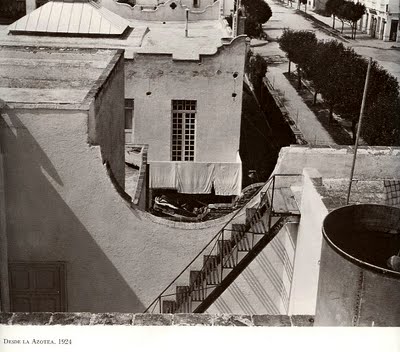 I have such a vivid memory about reading this article on Mexican photographer Manuel Alvarez Bravo on December 16, 1993 that I even remember it was a Thursday!
I have such a vivid memory about reading this article on Mexican photographer Manuel Alvarez Bravo on December 16, 1993 that I even remember it was a Thursday!
The idea that the 91 year-old man (he died when he was 100) would wake up every day and have a coffee, pan dulce and then go to his studio and photograph a female nude was astounding. What a routine he had! That he did it in a city without snow or cold, a city (as well as the mountains of the dry season) that is ochre (although Bravo's house was called the Blue House) brown, and red, colours that are inviting and not distancing like the greens, blues, cyans and grays of Vancouver gave me nostalgia for my youth in Mexico City. Reading Tim Golden's interview with Bravo I could imagine the smells of earth, water on sidewalks after a winter drought aguacero and the advent of the rainy season. I could imagine and remember the murals of Diego Rivera and paintings by Rufino Tamayo. But most of all I was grabbed by the last two paragraphs of the interview:
For many years, Mr. Alvarez Bravo used to summarize the philosophy of his method on a piece of paper tacked above the developing pans in his darkroom. "Hay tiempo," it read, "There is time."
When asked, he can't remember exactly what happened to the manifesto. He thinks it is back in the house, just up the crooked street from the blue wall of his studio. he isn't sure. But he smiles as he says this, and his meaning is obvious: there is no longer any need for such reminders.
It was around 1993 that I first read the Daybooks of Edward Weston with special emphasis on the first volume. 1 Mexico. But I skimmed through them without giving Weston's words much thought.
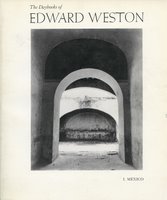 Of late I have given those words much thought and I have read them over and over. It was only a few years ago that I realized, that between 1962 and 1964, when I lived in an apartment on Avenida Tamaulipas in Mexico City, that I was but three blocks from Avenida Veracruz 42, corner with Durango. It was in this house that Edward Weston lived for a while in 1924 with some of his sons and his mistress the Italian photographer Tina Modotti. When Modotti was later expelled from Mexico for her communist views she sold one of Weston's 4x5 cameras to a young Manuel Alvarez Bravo. Weston had noticed Bravo's photographs and commented on his talent.
Of late I have given those words much thought and I have read them over and over. It was only a few years ago that I realized, that between 1962 and 1964, when I lived in an apartment on Avenida Tamaulipas in Mexico City, that I was but three blocks from Avenida Veracruz 42, corner with Durango. It was in this house that Edward Weston lived for a while in 1924 with some of his sons and his mistress the Italian photographer Tina Modotti. When Modotti was later expelled from Mexico for her communist views she sold one of Weston's 4x5 cameras to a young Manuel Alvarez Bravo. Weston had noticed Bravo's photographs and commented on his talent.
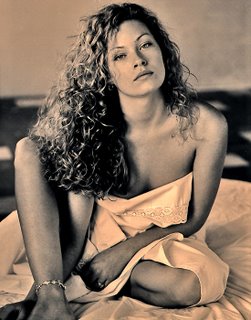 Ona Grauer in my studio, (right)
Ona Grauer in my studio, (right)
On a March 12, 1924 entry Weston writes:
From the negatives made of Tina lying nude on the azotea, (Weston's photograph from his azotea, above left)[a Mexican roof, complete with laundry hanging to dry next to large water tanks] one very excellent result which I have printed: it is among the best nudes I have done...
Or his entry for March 16. 5:30 [Morning or afternoon?] ...Some criticized my latest nude of Tina reclining on the azotea because of "incorrect drawing," but [Jean] Charlot did not mind it: he tells me that Picasso got his "inspiration" to use false perspective from amateur photographs. Diego [Diego Rivera] had another interesting note on Picasso, that he was never influenced or went to nature for inspiration, always to other "schools" of art.
And there is this torrid one, March 23, Sunday Evening:
After a day of loafing and napping, it is well to let the world slip by occasionally in indolent indifference. The twilight was spent in Tina's room and in her arms, for she had sent me a note by Elisa, "Eduardo: Por qué no viene aquí arriba? Es tan bella la luz a esta hora y yo estoy un poco triste. "Why not come up here? The light is beautiful at this hour and I am a little sad.
There is a certain inevitable sadness in the life of a much-sought-for, beautiful woman, one like Tina especially, who, not caring sufficiently for associates among her own sex, craves camaraderie and friendship from men as well as sex love.
There is one entry that mentions a very young and beautiful "starlet" called Dolores del Río. But my favourite is one that sunk in with all its loveliness of a father's affection for his sons, in this case Neil:
March 3. It so happened, Neil, that last night I dreamed of you. I held you on my lap, kissed your broad forehead, and you cuddled close, and asked for stories. We talked long together, of fierce fanged Aztec Gods, of white rabbits in clover fields - and we recalled days of long ago. How it used to be at bed time you would climb upon my back for a good night ride out under the tall black trees, waving farewell to Lady Moon, listening to the little pines whisper, or maybe, picking loquat blossoms fragrant in the night fog. Now you are there[California] and I am here, and perhaps you are so big a boy I could no longer ride you so. Well it came to pass that in my dream your dreamed too...All quiet now, only a distant mocking. I watched your sleeping face, as I looked down upon you, you became not only Neil, but the symbol for all in life of tender hopefulness. They will flout you, insult you, lynch you, but I will protect you, for I have masks that you shall wear, a horned and grinning devil, a sharp beaked bird, a ram in solemn mummery. I have them, I shall keep them for that hour when it must be you shall need them to hide behind and keep inviolate, untouched, the spark within which is yourself. They shall be my only legacy to you, carboard, painted masks, thicker than your thin skin...
As I read and re read Weston's diary and look at the icy cyan sky of the North Shore mountains I remember that I have a warm studio on Robson Street. It is either cold or very hot. There is no in between with that steam radiator. And I have my photographic assignations with some beautiful women who consent to my photography with no fixed purpose except to take pictures, to explore what they are and or what I think they are. I happily send them (after all this is the 21st century) digital contact sheets (of negatives scanned) and print up photographs that smell of fixer which almost smells of Mexico City earth.
I sometimes question my obsession with the undraped female form. Since I am unable to explain it all in brief here I decided to look for an answer in my copy of The Photographic Nudes of Erwin Blumenfeld. The book has Berlin-born Blumenfeld's exquisite and classy (tame by today's standards) and it is nicely written by his son Yorick. Of his father he writes:
Women were the truest of his many obsessions and photography was one way of capturing them, of possessing them. The art historian Joachim Gasquet has described how Cézanne symbolically seduced his nudes in his great canvases, stroking them with 'great coloured caresses'. Gasquet wrote: "Nude flesh made him giddy, he wanted to leap at his models; as soon as they came in he wanted to throw them, half undressed, onto a matress...He had found another wasy to adore those nudes...he bedded them in his paintings, tussled with them." To Gasquet's conjectures about Cézzane, I can only add my own about my father. I don't think that his sublimations were all that different, except that he used the intermediary of the lens instead of the brush. Certainly he placed all kinds of separating elements between himself and his models: veils, grids, glass plates, silks muslin sheets...all used effectively to increase distance, to introduce the element of mystery, to heighten the allure of eroticism.
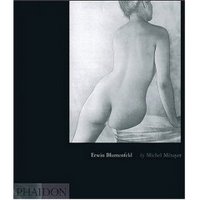 Yorick Blumenfeld has something interesting to say about Edward Weston:
Yorick Blumenfeld has something interesting to say about Edward Weston:
Whatever desires may have been aroused by taking nude pictures were according to Blummenfeld 'sublimated by the lens.' Unlike other contemporary photographers, such as Edward Weston, he rarely focused his camera on the women he loved. He never used his wife, for example, as a nude model.
Of late I have been processing Agfa 400 ISO film after having exposed it to my studio's window lighting and getting blotchy negatives. I have been using the "wrong" developer to get results (the pictures look like they were taken in the 1920s) that Weston would have gone crazy to eliminate or correct. I have revelled in the use of this window lighting that I have so ignored in my years with my American-made, efficient and ever consistent Dynalites. Above you see pictures of two of my former studio muses, both photographed with window lighting. The first is Ona Grauer and the second is Yuliya Kam'yanska who really has the presence of the passionate Latin even though she is from Ukraine.
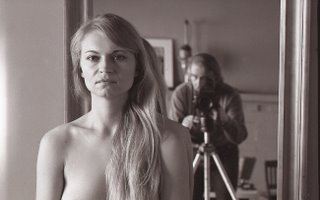
I have a new subject, Jo-Ann (left) who has indicated she will brave the outdoor metal stairs that hug the wall to my studio roof. It is not a Mexican azotea. But come the warm days of summer, it just might do!
¡Hay tiempo! There is time!
La Azotea de Edward Weston
Friday, March 21, 2008
 I have such a vivid memory about reading this article on Mexican photographer Manuel Alvarez Bravo on December 16, 1993 that I even remember it was a Thursday!
I have such a vivid memory about reading this article on Mexican photographer Manuel Alvarez Bravo on December 16, 1993 that I even remember it was a Thursday! The idea that the 91 year-old man (he died when he was 100) would wake up every day and have a coffee, pan dulce and then go to his studio and photograph a female nude was astounding. What a routine he had! That he did it in a city without snow or cold, a city (as well as the mountains of the dry season) that is ochre (although Bravo's house was called the Blue House) brown, and red, colours that are inviting and not distancing like the greens, blues, cyans and grays of Vancouver gave me nostalgia for my youth in Mexico City. Reading Tim Golden's interview with Bravo I could imagine the smells of earth, water on sidewalks after a winter drought aguacero and the advent of the rainy season. I could imagine and remember the murals of Diego Rivera and paintings by Rufino Tamayo. But most of all I was grabbed by the last two paragraphs of the interview:
For many years, Mr. Alvarez Bravo used to summarize the philosophy of his method on a piece of paper tacked above the developing pans in his darkroom. "Hay tiempo," it read, "There is time."
When asked, he can't remember exactly what happened to the manifesto. He thinks it is back in the house, just up the crooked street from the blue wall of his studio. he isn't sure. But he smiles as he says this, and his meaning is obvious: there is no longer any need for such reminders.
It was around 1993 that I first read the Daybooks of Edward Weston with special emphasis on the first volume. 1 Mexico. But I skimmed through them without giving Weston's words much thought.
 Of late I have given those words much thought and I have read them over and over. It was only a few years ago that I realized, that between 1962 and 1964, when I lived in an apartment on Avenida Tamaulipas in Mexico City, that I was but three blocks from Avenida Veracruz 42, corner with Durango. It was in this house that Edward Weston lived for a while in 1924 with some of his sons and his mistress the Italian photographer Tina Modotti. When Modotti was later expelled from Mexico for her communist views she sold one of Weston's 4x5 cameras to a young Manuel Alvarez Bravo. Weston had noticed Bravo's photographs and commented on his talent.
Of late I have given those words much thought and I have read them over and over. It was only a few years ago that I realized, that between 1962 and 1964, when I lived in an apartment on Avenida Tamaulipas in Mexico City, that I was but three blocks from Avenida Veracruz 42, corner with Durango. It was in this house that Edward Weston lived for a while in 1924 with some of his sons and his mistress the Italian photographer Tina Modotti. When Modotti was later expelled from Mexico for her communist views she sold one of Weston's 4x5 cameras to a young Manuel Alvarez Bravo. Weston had noticed Bravo's photographs and commented on his talent. Ona Grauer in my studio, (right)
Ona Grauer in my studio, (right)On a March 12, 1924 entry Weston writes:
From the negatives made of Tina lying nude on the azotea, (Weston's photograph from his azotea, above left)[a Mexican roof, complete with laundry hanging to dry next to large water tanks] one very excellent result which I have printed: it is among the best nudes I have done...
Or his entry for March 16. 5:30 [Morning or afternoon?] ...Some criticized my latest nude of Tina reclining on the azotea because of "incorrect drawing," but [Jean] Charlot did not mind it: he tells me that Picasso got his "inspiration" to use false perspective from amateur photographs. Diego [Diego Rivera] had another interesting note on Picasso, that he was never influenced or went to nature for inspiration, always to other "schools" of art.
And there is this torrid one, March 23, Sunday Evening:
After a day of loafing and napping, it is well to let the world slip by occasionally in indolent indifference. The twilight was spent in Tina's room and in her arms, for she had sent me a note by Elisa, "Eduardo: Por qué no viene aquí arriba? Es tan bella la luz a esta hora y yo estoy un poco triste. "Why not come up here? The light is beautiful at this hour and I am a little sad.
There is a certain inevitable sadness in the life of a much-sought-for, beautiful woman, one like Tina especially, who, not caring sufficiently for associates among her own sex, craves camaraderie and friendship from men as well as sex love.
 |
| Yuliya in my studio |
March 3. It so happened, Neil, that last night I dreamed of you. I held you on my lap, kissed your broad forehead, and you cuddled close, and asked for stories. We talked long together, of fierce fanged Aztec Gods, of white rabbits in clover fields - and we recalled days of long ago. How it used to be at bed time you would climb upon my back for a good night ride out under the tall black trees, waving farewell to Lady Moon, listening to the little pines whisper, or maybe, picking loquat blossoms fragrant in the night fog. Now you are there[California] and I am here, and perhaps you are so big a boy I could no longer ride you so. Well it came to pass that in my dream your dreamed too...All quiet now, only a distant mocking. I watched your sleeping face, as I looked down upon you, you became not only Neil, but the symbol for all in life of tender hopefulness. They will flout you, insult you, lynch you, but I will protect you, for I have masks that you shall wear, a horned and grinning devil, a sharp beaked bird, a ram in solemn mummery. I have them, I shall keep them for that hour when it must be you shall need them to hide behind and keep inviolate, untouched, the spark within which is yourself. They shall be my only legacy to you, carboard, painted masks, thicker than your thin skin...
As I read and re read Weston's diary and look at the icy cyan sky of the North Shore mountains I remember that I have a warm studio on Robson Street. It is either cold or very hot. There is no in between with that steam radiator. And I have my photographic assignations with some beautiful women who consent to my photography with no fixed purpose except to take pictures, to explore what they are and or what I think they are. I happily send them (after all this is the 21st century) digital contact sheets (of negatives scanned) and print up photographs that smell of fixer which almost smells of Mexico City earth.
I sometimes question my obsession with the undraped female form. Since I am unable to explain it all in brief here I decided to look for an answer in my copy of The Photographic Nudes of Erwin Blumenfeld. The book has Berlin-born Blumenfeld's exquisite and classy (tame by today's standards) and it is nicely written by his son Yorick. Of his father he writes:
Women were the truest of his many obsessions and photography was one way of capturing them, of possessing them. The art historian Joachim Gasquet has described how Cézanne symbolically seduced his nudes in his great canvases, stroking them with 'great coloured caresses'. Gasquet wrote: "Nude flesh made him giddy, he wanted to leap at his models; as soon as they came in he wanted to throw them, half undressed, onto a matress...He had found another wasy to adore those nudes...he bedded them in his paintings, tussled with them." To Gasquet's conjectures about Cézzane, I can only add my own about my father. I don't think that his sublimations were all that different, except that he used the intermediary of the lens instead of the brush. Certainly he placed all kinds of separating elements between himself and his models: veils, grids, glass plates, silks muslin sheets...all used effectively to increase distance, to introduce the element of mystery, to heighten the allure of eroticism.
 Yorick Blumenfeld has something interesting to say about Edward Weston:
Yorick Blumenfeld has something interesting to say about Edward Weston:Whatever desires may have been aroused by taking nude pictures were according to Blummenfeld 'sublimated by the lens.' Unlike other contemporary photographers, such as Edward Weston, he rarely focused his camera on the women he loved. He never used his wife, for example, as a nude model.
Of late I have been processing Agfa 400 ISO film after having exposed it to my studio's window lighting and getting blotchy negatives. I have been using the "wrong" developer to get results (the pictures look like they were taken in the 1920s) that Weston would have gone crazy to eliminate or correct. I have revelled in the use of this window lighting that I have so ignored in my years with my American-made, efficient and ever consistent Dynalites. Above you see pictures of two of my former studio muses, both photographed with window lighting. The first is Ona Grauer and the second is Yuliya Kam'yanska who really has the presence of the passionate Latin even though she is from Ukraine.

I have a new subject, Jo-Ann (left) who has indicated she will brave the outdoor metal stairs that hug the wall to my studio roof. It is not a Mexican azotea. But come the warm days of summer, it just might do!
¡Hay tiempo! There is time!







